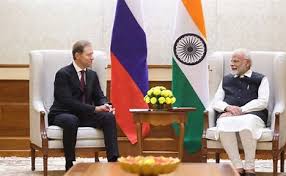 The new foreign trade policy (2015-20) announced by Commerce Minister Nirmala Sitharaman recently is aimed at doubling India’s exports from $465.9 billion in 2013-14 to $900 billion in 2020. Exports of goods and services are important for enhancing India’s GDP growth, especially because high export growth will lead to the creation of more jobs in the manufacturing sector and the fulfillment of the ‘Make in India’ dream. India, however, has to gain the reputation of producing good quality, zero-defect products which can compete in international markets. To achieve this goal, much needs to be done.
The new foreign trade policy (2015-20) announced by Commerce Minister Nirmala Sitharaman recently is aimed at doubling India’s exports from $465.9 billion in 2013-14 to $900 billion in 2020. Exports of goods and services are important for enhancing India’s GDP growth, especially because high export growth will lead to the creation of more jobs in the manufacturing sector and the fulfillment of the ‘Make in India’ dream. India, however, has to gain the reputation of producing good quality, zero-defect products which can compete in international markets. To achieve this goal, much needs to be done.
India’s exports in the last few months have been languishing and it contracted by 15 per cent in February 2015 as compared to the previous year. The main problems in the export sector are: infrastructural bottlenecks, high transaction costs and complex bureaucratic procedures. In addition, global factors also play an important role.
Two new schemes — the Merchandise Exports India Scheme (MEIS) and the Service Exports India Scheme (SEIS) – have been introduced in the new foreign trade policy. The import duty credit scrips issued under these schemes and goods imported against these are now fully transferable and can be used to pay customs and excise duties and the service tax. These duty credit scrips will be applied to SEZs also and are likely to give them a boost.
Measures have been taken to encourage Indian capital goods industries under the Export Promotion of Capital Goods Scheme by reducing specific export obligations to 75 per cent in case of domestic capital goods. This will promote the domestic capital goods industry. With more flexibility, exporters will be able to develop their production capacity more efficiently.
Export processing zones have been given much prominence in the new trade policy and emphasis is on the role of states in improving the infrastructural conditions in the EPZs. Most importantly, states will have to prepare their own strategies, work plans and incentives for capacity building for exports. The states will have to decrease infrastructure bottlenecks and upgrade ports, roads, railways and airports. They will have to install more testing labs and larger trade facilitation centres, including cold storage facilities for pharmaceuticals and perishable products.
The money for state infrastructure comes from the ASIDE (Assistance to States for Infrastructure Development for Exports) but in the recent budget ( 2015-16) the allocation to the ASIDE has been severely cut. This is because with the new increased tax devolution to the states under the divisible pool by 10 per cent (from 32 per cent to 42 per cent) by the 14th Finance Commission, the onus is now on the states to finance infrastructure from the additional revenue sharing. Will they do so? After six months there will be a review.
Exports have been given a thrust especially at a time when exports of both merchandise and service exports have been languishing. Service exports grew only at 4 per cent in 2013-14 mainly due to problems in demand from the US and the EU. The EU, which is one of the main trade partners, has been experiencing a slowdown even as the US is experiencing economic recovery. For service sector exports lack of diversification of products seems to be the main stumbling block.
As for merchandise exports, the Gulf states are experiencing a slowdown in demand because of a fall in oil revenue. China, an important trade partner, is also facing economic slowdown and this is likely to affect the global demand for raw materials and commodities. India as a supplier of raw materials to China will be affected though the fall in raw material prices worldwide may benefit India’s building of smart cities.
Export growth will always remain vulnerable to ups and downs in foreign demand and that is why China has decided to move away from export-led growth. China is now focused on raising domestic demand for goods and services. India, however, needs higher export growth to build its foreign exchange reserves even though it has substantial foreign exchange reserves of $343 billion.
India remains vulnerable to currency fluctuations that affect export growth and the RBI has to stabilise the rupee from time to time by injecting or withdrawing dollars into the monetary system. It is thus important for the RBI to have sufficient reserves and not be dependent on FIIs who bring in dollars for portfolio investment but also keep moving their capital out of the country, causing gyrations in the value of the rupee.
Of late the value of the rupee has become vulnerable due to the movement of FIIs out of India and going towards the US because there is a good possibility that the US Federal Reserve will hike up the interest rates on the basis of positive signs of economic recovery. Investments in India by FIIs fell by 31.5 per cent in March 2015, especially in bonds.
Thus for the new foreign trade policy to become effective, a rise in global demand and stability of the rupee are important. The rupee’s exchange rate is also dependent on the balance of payments situation, especially the current account. Because of the fall in global oil prices, the current account deficit is under control, otherwise the widening of the current account deficit would have put pressure on the Indian rupee. Fortunately, of late the rupee has been one of the most stable currencies in the world.
The online filing of documents and emphasis on paperless trade is a welcome item and is in line with India’s digitalisation programme. Other features are strict quality control and the role of Micro Small and Medium Enterprises in exports. MSMEs account for 40 per cent of exports and are constrained by lack of finance, technology and marketing channels. Cluster formations for small and medium units are important so that they get infrastructural support. MSMEs produce 600 quality products – from gems and jewellery to auto and machine parts. An Interest rate subvention for 3 years has been worked out and a budget allocation has been made. Most importantly, the question of ‘ease of doing business’ has been addressed.
(The writer is a Senior Fellow at Observer Research Foundation, Delhi)
(courtesy:ORF)
Author Profile
- India Writes Network (www.indiawrites.org) is an emerging think tank and a media-publishing company focused on international affairs & the India Story. Centre for Global India Insights is the research arm of India Writes Network. To subscribe to India and the World, write to editor@indiawrites.org. A venture of TGII Media Private Limited, a leading media, publishing and consultancy company, IWN has carved a niche for balanced and exhaustive reporting and analysis of international affairs. Eminent personalities, politicians, diplomats, authors, strategy gurus and news-makers have contributed to India Writes Network, as also “India and the World,” a magazine focused on global affairs.
Latest entries
 India and the WorldNovember 26, 2025G20@20: Africa’s Moment – The Once and Future World Order
India and the WorldNovember 26, 2025G20@20: Africa’s Moment – The Once and Future World Order DiplomacyOctober 4, 2025UNGA Resolution 2758 Must Not Be Distorted, One-China Principle Brooks No Challenge
DiplomacyOctober 4, 2025UNGA Resolution 2758 Must Not Be Distorted, One-China Principle Brooks No Challenge India and the WorldJuly 26, 2025MPs, diplomats laud Operation Sindoor, call for national unity to combat Pakistan-sponsored terror
India and the WorldJuly 26, 2025MPs, diplomats laud Operation Sindoor, call for national unity to combat Pakistan-sponsored terror India and the WorldJuly 25, 2025When Fire Ends, Diplomacy Begins
India and the WorldJuly 25, 2025When Fire Ends, Diplomacy Begins







